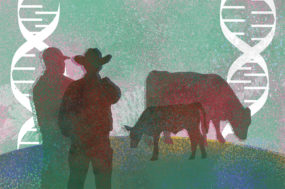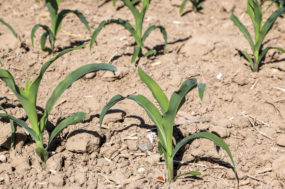In 1993 the United Nations Food and Agriculture Organization/World Health Organization (UNFAO/WHO) Joint Committee on Food Safety found no evidence of adverse health effects even at exaggerated dose levels. This was re-affirmed in 1998. Even so, some countries, including Canada and the European Union, do not allow use of bST.
After 20 years of commercial use in the U.S. on over 35 million cows, additional research and field observations have shown use of bST 1) has not increased human exposure to milk antibiotic residues, 2) has not affected expression of retroviruses in cattle 3) and does not increase risk of Type I and Type II diabetes in children and adults consuming dairy products.
However, many consumers still avoid milk products produced with bST and the UNFAO/WHO committee plans to reevaluate bST. It seems there is sometimes never enough science, or practical experience, to counteract human emotion.
A genetic silver bullet for reproduction?
Prior research had identified a possible genetic source of variation in reproduction. In short, the effect was a specific genetic deletion on a particular chromosome. Researchers evaluated two populations of cattle for evidence of this deletion: 1) Bos taurus of various breed background in central Nebraska and 2) Bos taurus-Bos indicus cattle in central Florida.
No evidence of the deletion was found in the Bos taurus samples. In cows open two successive years in the Bos taurus-Bos indicus group, frequency of the deletion was 7 percent. The researchers concluded that, in cattle of some Bos indicus influence, the particular genetic location may provide opportunity to be used for selection of cattle for improved female fertility.
Effect of size on heifer growth and reproduction
Size can be stated as either body weight or skeletal dimension. A commonly used system of skeletal dimension is frame score, determined by height at the hooks. Two spring-calving cow herds were available for study. One herd historically averaged 1220 pounds mature weight; the other averaged 1470 pounds mature weight.
Heifers in this study from those herds averaged frame score 3.50 and 5.56 respectively. (Based on the historical mature weights, a frame score equaled about 120 pounds per frame score, similar to that found in other research.) Heifers were grazed on dormant range from mid-October to mid-May, on growing pasture to early July and placed in drylot to late September. Heifers were bred during the last 50 days of the drylot period.
Small-frame heifers gained more during the first period, and large-frame gained more during the second and third periods. Overall, large-frame gained 40 pounds more (18 percent). At the start of breeding, small-frame averaged 705 pounds (58 percent of mature weight) and large-frame 841 pounds (57 percent of mature weight). Overall conception rate was 86 percent for small-frame and 84 percent for large frame, not statistically different.
In drylot, small-frame consumed 20 percent less feed and development cost was 16 percent lower. Feed efficiency and cost per pound gain did not differ. Large-frame cost a total of $21.94 more feed in drylot (16 percent more). The authors noted that, as in some previous research, acceptable breeding performance can be realized by developing heifers to 55 to 60 percent of projected mature weight, as opposed to 60 to 65 percent previously recommended, with accompanying reduced cost.
Note: Based on projected mature weights in this study, for every 100 small-frame cows only 87 large-frame cows could be maintained on the same nutritional resource.
Should greater maturity require more marbling?
For purposes of grading for quality, the USDA standards include evaluation of maturity. Maturity is based on visual evaluation of bone, cartilage and muscle characteristics, so it is an estimate of physiological rather than chronological maturity.
A-maturity carcasses are thought to be from animals 9 to 30 months old, B-maturity from 30 to 42 months, C-maturity 42 to 72 months, D-maturity 72 to 96 months, and E-maturity greater than 96 months. For some purposes, including eligibility for export to some countries, maturity is evaluated by dental characteristics. In most of those applications, 30 months old is the maximum allowed for export (in an effort to eliminate possibility of BSE, which is rarely found in younger animals).
Select grade carcasses must be A-maturity. Choice and prime grade carcasses can be B-maturity but only with a higher degree of marbling.
A study was conducted to compare maturity with beef desirability. Carcasses were included only from cattle evaluated by dentition before slaughter as being less than 30 months old. A group of 300 carcasses meeting that pre-slaughter requirement was then classified by traditional carcass maturity factors as being either A or B-C; equal numbers in both maturity categories had slight, small or modest marbling (select, low-choice and mid-choice for A-maturity). Strip loin steaks were aged 14 days and then evaluated.
There were no statistically significant differences between the A and B-C groups in mechanical tenderness or taste-panel tenderness, juiciness or flavor. As marbling increased, quality measurements increased. The authors concluded that “when applied to grain-finished cattle whose dental ages are less than 30 months, USDA quality grades would be no less effective in identifying eating quality differences if the A and B-C maturity groups were combined and quality grades assigned using only marbling.”
That is, in grain-fed cattle sorted by dentition, higher marbling should not be required for a given grade. But any such change would require revision of the USDA standards.
Increasing consumption of beef
A survey funded by Beef Checkoff of over 3000 consumers examined possible ways to increase beef consumption. For all of the following, 23 percent to 31 percent of consumers indicated they would “definitely increase” buying and 34 percent to 45 percent would “probably increase” buying if they knew:
- 4 ounces of beef has the same cholesterol as 4 ounces of skinned chicken breast.
- Beef is an excellent or good source of 10 essential nutrients.
- Lean beef helps maintain healthy weight, builds muscle and fuels physical activity.
- Lean beef fits as well as chicken or fish for heart health.
- Most popular steaks have less than 10 percent fat after being cooked and trimmed.
- U.S. testing prevents beef being sold that has added hormones remaining.
- Most beef cattle spend most of their life grazing on pastures, on farms and on ranches.
Their beef consumption may increase if they also saw:
- Greater availability of large-quantity packs with lower price per pound
- Greater availability of trimmed 4 to 5 ounce steaks with less than 200 calories in large packs
- Greater availability of trimmed, economically priced 4 to 5 ounce steaks in restaurants
Genetic relationship of performance traits and reproduction
Records from 156,506 Bos taurus, mostly crossbred females were used to assess genetics of reproduction and its relationship to performance. Reproductive traits studied were age at first calving, calving within first 42 days, interval between consecutive calvings and survival to next lactation. Performance traits studied were dystocia, linear type traits (describing skeletal, muscular and functional characteristics of an animal), live weight and price, carcass traits and subjectively scored weaning quality and docility.
Heritability of age at first calving was 0.31, but was only 0.01 to 0.06 for the other reproductive traits. Genetic correlations between reproductive traits indicated:
- Heifers younger at first calving calve later, but thereafter as cows calve earlier.
- Females younger at first calving have shorter lifetime calving intervals but also leave the herd earlier (have lower survival).
- Heifers calving earlier continue calving earlier as cows and have shorter calving intervals, but with little effect on survival.
- Cows calving earlier have shorter calving intervals and longer survival.
- Females with longer calving intervals have shorter survival in the herd.
Reproduction was generally lowly correlated with performance traits, except that heavier, more muscular cows had reduced performance for some reproductive traits. The authors concluded that “breeding goals for muscularity and live weight or growth rate should be cognizant of indirect response to selection that may cause any deterioration in reproductive performance.”
What is the optimal yield grade?
Carcasses with superior (numerically lower) yield grade have higher value when sold on a carcass value grid. But yield grade is only one of the factors determining carcass value. A recent report analyzed carcass data collected in calendar year 2013 by a major high-quality beef company. Carcasses from a natural program or that had received zilpaterol were excluded. Averages were calculated for the five yield grades:
- Carcass weight increased from 830 pounds for YG1 to 935 pounds for YG2.
- Fat cover increased from 0.26 inches for YG1 to 0.98 inches for YG5.
- Ribeye area decreased from 16.2 square inches for YG1 to 11.8 square inches for YG5.
- Carcasses discounted for excess weight increased from 3 percent for YG1 to 23 percent for YG5.
- Quality grade increased from high select for YG1 to mid-choice for YG5.
- Choice-prime combined increased from 34 percent for YG1 to 95 percent for YG5.
- Prime increased from 0.2 percent for YG1 to 15 percent for YG5.
Carcass price per hundredweight (cwt) and total dollars per carcass were:
- YG1 $193.75 and $1609
- YG2 $197.94 and $1684
- YG3 $201.04 and $1762
- YG4 $196.98 and $1783
- YG5 $189.45 and $1770
The report concluded that YG3 was optimum.
Note: While YG4 and YG5 had slightly higher total dollar return, these cattle were fatter so they would probably have been less feed efficient late in the finishing period and/or fed longer, thus increasing cost and reducing their net return.
Animal feed versus human food
The debate continues as to whether feed for livestock competes for human food and is inefficient and wasteful. A recent report found that:
- Global animal agriculture provides a wide array of safe, affordable and nutrient-dense food products and useful by-products.
- Livestock are important not only in developed countries but also in developing countries, where draft power from livestock is important.
- Much of the Earth’s land surface is not capable of producing crops for human food but can be effectively and sustainably used by livestock.
- Livestock can effectively and economically use by-products from production of human food and fiber that would otherwise not be well utilized.
- Improved communication is needed between producers and consumers for a better understanding of the economic, environmental, nutritional and social benefits from animal agriculture.

Dr. Stephen Hammack is professor and extension beef cattle specialist emeritus at Texas A&M University. This originally appeared in the Beef Cattle Browsing newsletter.
References omitted but available upon request. Email editor@progressivecattleman.com.







